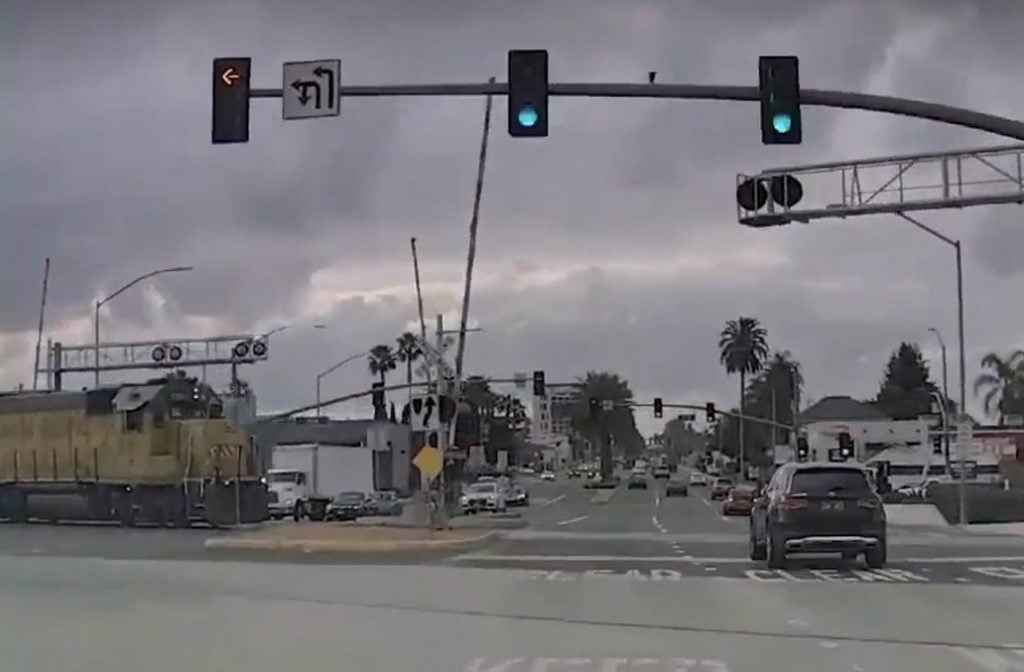Malfunctioning railroad crossing signals are increasingly putting California drivers at risk, a stark reality brought into focus by a near-catastrophic incident in Buena Park.
In the early morning hours of January 30, a Korean-American driver narrowly escaped a collision with a freight train after the crossing’s signals and barriers failed to operate correctly—a dangerous malfunction that has prompted fresh calls for overhauled safety measures and clearer reporting systems.
At around 9:48 a.m. on a busy stretch of Beach Boulevard—a major route linking Buena Park, Fullerton, and La Mirada—a routine drive quickly turned into a heart-stopping encounter.
Hannah Song, who was riding in a Tesla at the time, recalls the surreal moment when her car abruptly came to a halt just seconds before a speeding freight train barreled through the intersection.

In a video she later provided, the Tesla can be seen slamming on its brakes as the train looms unexpectedly. Despite the presence of an “RXR” railroad warning sign on the pavement and a green traffic light that suggested it was safe to proceed, the crossing’s warning system failed entirely.
The flashing yellow lights and lowering barriers that are supposed to alert drivers of an oncoming train never activated, leaving motorists in a false sense of security.
The incident was compounded by the fact that a line of vehicles, including a speeding black Mercedes-Benz SUV in an adjacent lane, was queued to enter the freeway, further obscuring the view of the oncoming train.
“I drive this road all the time because my office is nearby, and I was shocked,” Song later remarked. “There are so many Koreans who live and drive in this area. I felt it was important to warn people to be careful.”
Her experience is not an isolated case. Similar accounts have emerged from other parts of Southern California, including a troubling incident recounted by Hyeseung Jung near the Meridian Avenue and Mission Street crossing in Pasadena.
Jung recalled that as she passed through the intersection, there was no audible warning, no lowered gate—just a persistent green light before a train suddenly rushed by, forcing several drivers to brake sharply and igniting frustration among onlookers.
The frequency of such near-misses and accidents is alarmingly high. Data from the Federal Railroad Administration indicates that California recorded 835 railroad crossing accidents between 2020 and 2024, with incidents rising by approximately 15% from 150 in 2020 to 173 in 2023.
Last year alone, 94 people were either injured or killed in collisions at railroad crossings statewide—a grim statistic that underscores the urgency of addressing the malfunctioning safety systems. Los Angeles County led the figures with 128 reported cases, followed by San Bernardino, San Diego, Riverside, and Orange County.
A major concern emerging from these incidents is the fragmented nature of oversight and reporting for railroad crossings. The Buena Park crossing, for instance, falls under the jurisdiction of Caltrans and the Union Pacific Railroad, leaving local residents confused about where to report signal malfunctions when no collision occurs.
Song’s experience highlights a systemic issue: “I was nearly in a fatal accident, but I had no idea where to report the issue. Even after asking around, no one seemed to know.” This lack of a centralized, user-friendly reporting system has not only left drivers feeling vulnerable but also hinders prompt corrective action by the responsible agencies.
Attorney Misoo Lee, who specializes in transportation safety issues, warns that if a malfunctioning signal system were to lead to a fatal accident, the agencies involved could face significant legal liability.
Yet, without clear guidelines on whom to contact, many drivers may remain unaware of the steps they need to take. Although Union Pacific Railroad provides a hotline (800-848-8715) for reporting issues, the system requires callers to know specific crossing identification numbers—information that is not readily accessible to the average motorist. For example, the Beach Boulevard crossing is designated as 748145F, a detail that few would recognize in an emergency.
The confluence of technical failure, bureaucratic complexity, and rising accident statistics paints a dire picture for California’s road safety. As the state grapples with an increasing number of railroad crossing incidents, urgent reforms are needed—not only in the technology that governs these crossings but also in the protocols that guide maintenance and emergency reporting.
By Mooyoung Lee [lee.mooyoung@koreadaily.com]




